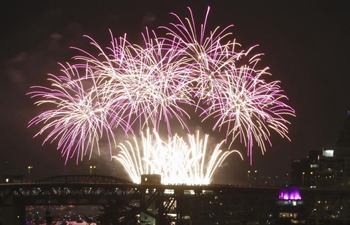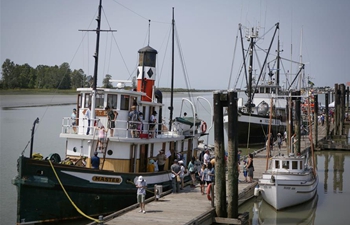by: Evan Duggan
VANCOUVER, July 29 (Xinhua) -- Maartje Meijaer sits on the deck of the Thane. It's a 57-foot-long sailing boat built in 1976 in the British Columbian capital of Victoria.
The boat sits moored on the Steveston village waterfront in the Metro Vancouver city of Richmond. It's here as part of the 15th annual Richmond Maritime Festival.
The Thane, Meijaer explains, is a replica of a sailboat that the legendary Joshua Slocum captained as he became the first man to sail around the world entirely on his own.
This boat is now retired after spending years providing tours throughout the nearby Juan de Fuca Strait, Meijaer says.
Its owner is now planning his own big trip.
"Next month he is heading down to San Diego," she tells Xinhua. "After that, through the Panama Canal and to the East Coast with his wife."
The boat is one of about seven others stationed and open to the public here at the festival, including old tug boats, fishing boats and sailboats that are part of the fabric of B.C.'s coastal history.
The festival site is also home to a pair of Canadian National Historic Sites, including the Britannia Shipyard, which is Canada's oldest preserved shipbuilding location.
"It's over 120 years old," says Ted Townsend, a spokesman with the City of Richmond.
"There was a lot of shipbuilding that was happening there, primarily to support the fishing industry," he says. "And a lot of the other buildings that are here were involved with the fishing industry in one way or another."
He said Richmond's history of fishing, canning and shipbuilding dates back more than 150 years.
Inside one of the massive shipyard buildings, an older couple and a young family peruse the old timber structure, looking at old shipbuilding tools and machinery. The space, which has been preserved as a museum, smells of oil and salt and looks like it could be operational tomorrow. Even its office looks ready for use.
At its peak, there were about 15 fish canneries along a two-kilometre stretch of the Steveston waterfront, which rests at the mouth of the Fraser River.
"Here are the Steveston waterfront we had all sorts of cultures represented," Townsend says. "There were a lot of Japanese fishermen that immigrated from Japan to fish here. There were a lot of Chinese immigrants that came in to work in the canneries. Of course, of lot of European immigrants were here working, as well as First Nations."
Now the waterfront is home to mostly seafood shops, condos and a boardwalk with lovely views of the river.
"The heyday of the fishing industry was probably around 1900 through until the 1920s and 1930s when it was still quite the going concern," Townsend says. "And even as late as the 1980s, there were still operating canneries on the Steveston waterfront... A lot of that area has now been redeveloped."
He says the two-day festival usually attracts about 25,000 visitors, who come down for a variety of music and food trucks and to wander through the historic seaside buildings and boats.
"Every year we've been restoring some of the buildings here on the site and introducing new exhibits on site," Townsend says. "We are continuing to develop it and make it a great place for people to come and visit and learn about the history of Richmond's maritime heritage."













